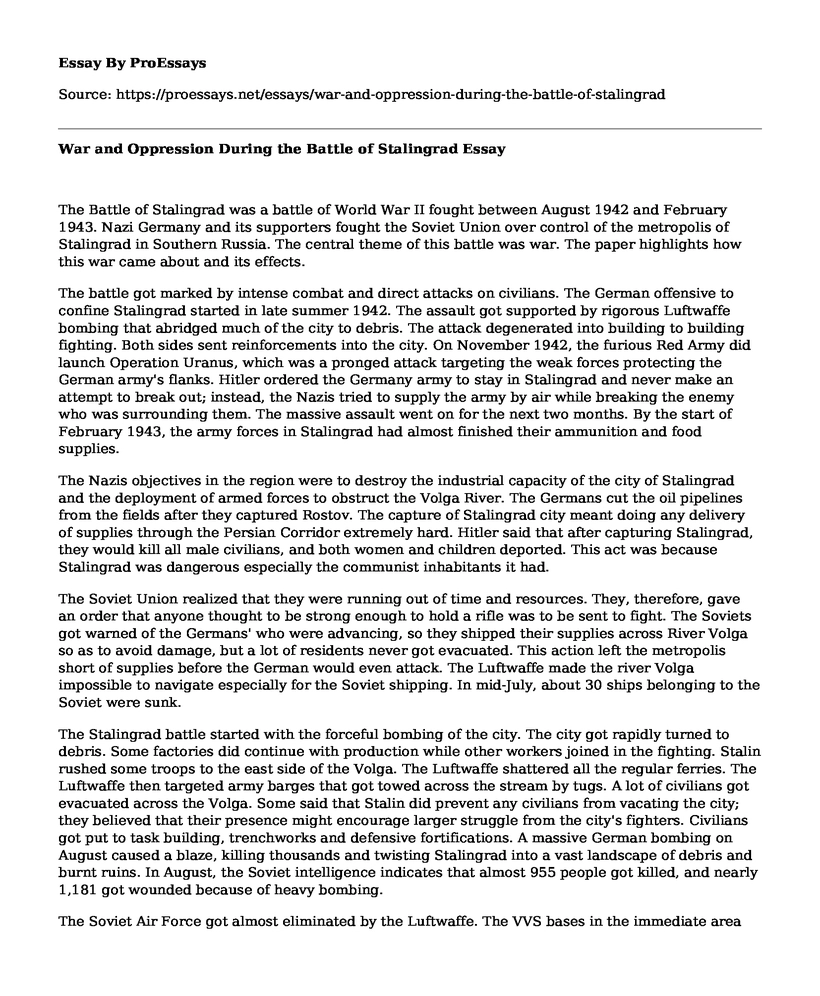The Battle of Stalingrad was a battle of World War II fought between August 1942 and February 1943. Nazi Germany and its supporters fought the Soviet Union over control of the metropolis of Stalingrad in Southern Russia. The central theme of this battle was war. The paper highlights how this war came about and its effects.
The battle got marked by intense combat and direct attacks on civilians. The German offensive to confine Stalingrad started in late summer 1942. The assault got supported by rigorous Luftwaffe bombing that abridged much of the city to debris. The attack degenerated into building to building fighting. Both sides sent reinforcements into the city. On November 1942, the furious Red Army did launch Operation Uranus, which was a pronged attack targeting the weak forces protecting the German army's flanks. Hitler ordered the Germany army to stay in Stalingrad and never make an attempt to break out; instead, the Nazis tried to supply the army by air while breaking the enemy who was surrounding them. The massive assault went on for the next two months. By the start of February 1943, the army forces in Stalingrad had almost finished their ammunition and food supplies.
The Nazis objectives in the region were to destroy the industrial capacity of the city of Stalingrad and the deployment of armed forces to obstruct the Volga River. The Germans cut the oil pipelines from the fields after they captured Rostov. The capture of Stalingrad city meant doing any delivery of supplies through the Persian Corridor extremely hard. Hitler said that after capturing Stalingrad, they would kill all male civilians, and both women and children deported. This act was because Stalingrad was dangerous especially the communist inhabitants it had.
The Soviet Union realized that they were running out of time and resources. They, therefore, gave an order that anyone thought to be strong enough to hold a rifle was to be sent to fight. The Soviets got warned of the Germans' who were advancing, so they shipped their supplies across River Volga so as to avoid damage, but a lot of residents never got evacuated. This action left the metropolis short of supplies before the German would even attack. The Luftwaffe made the river Volga impossible to navigate especially for the Soviet shipping. In mid-July, about 30 ships belonging to the Soviet were sunk.
The Stalingrad battle started with the forceful bombing of the city. The city got rapidly turned to debris. Some factories did continue with production while other workers joined in the fighting. Stalin rushed some troops to the east side of the Volga. The Luftwaffe shattered all the regular ferries. The Luftwaffe then targeted army barges that got towed across the stream by tugs. A lot of civilians got evacuated across the Volga. Some said that Stalin did prevent any civilians from vacating the city; they believed that their presence might encourage larger struggle from the city's fighters. Civilians got put to task building, trenchworks and defensive fortifications. A massive German bombing on August caused a blaze, killing thousands and twisting Stalingrad into a vast landscape of debris and burnt ruins. In August, the Soviet intelligence indicates that almost 955 people got killed, and nearly 1,181 got wounded because of heavy bombing.
The Soviet Air Force got almost eliminated by the Luftwaffe. The VVS bases in the immediate area lost a lot of air crafts in that August. The Soviets kept adding aerial support into the Stalingrad field in September, but ironically they continued to suffer huge losses; the Luftwaffe already had total control when it came to air attacks. By September, the Soviet Army had already been reduced to just a few tanks, an approximate of 700 mortars and about 20,000 personnel. The other remaining tanks got used as static strongpoints within the city. The Red Army progressively formed a scheme to clutch for as long as possible on the battleground in the Stalingrad city. They transformed multi-floored accommodation blocks, street corner residences and even office buildings into well-defended strongpoint with small units.
Most women did fight on the Soviet side, with some under fire. As of the war in Stalingrad, General Chuikov accredited that, by remembering clearly the defence of Stalingrad, people cannot ignore the very significant issue of the role that women had played in the Stalingrad battle. They went through the weight of combat life individually and together with men. During the commencement of the fight, there were almost 80,000 girls and women who had already finished military training and medical education. The Soviet nurses did not only treat wounded personnel but also got involved in other jobs like carrying wounded soldiers back to hospitals, under enemy fire. The Soviet telephone operators were also women who happened to have suffered heavy casualties. Many women did fight as snipers and even scouts.
Cite this page
War and Oppression During the Battle of Stalingrad. (2021, Mar 06). Retrieved from https://proessays.net/essays/war-and-oppression-during-the-battle-of-stalingrad
If you are the original author of this essay and no longer wish to have it published on the ProEssays website, please click below to request its removal:
- The Temple of Zeus Essay
- Who's the Star: Mao Zedong Essay
- The Life and Works of Chopin Essay
- List of Facts Pertaining to Egyptian's Life After Death
- Argumentative Essay Sample on Moral Justification of Japanese Bombing
- Essay on the Tragic Death of Princess Diana: A Conspiracy Theory
- Essay Sample on Enslaved Families in 19th Century: Heartbreaking Lives and Resilience







